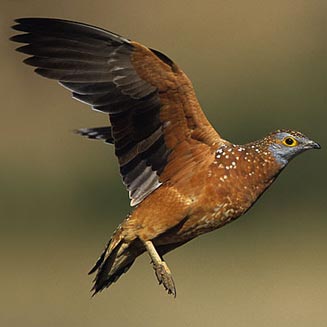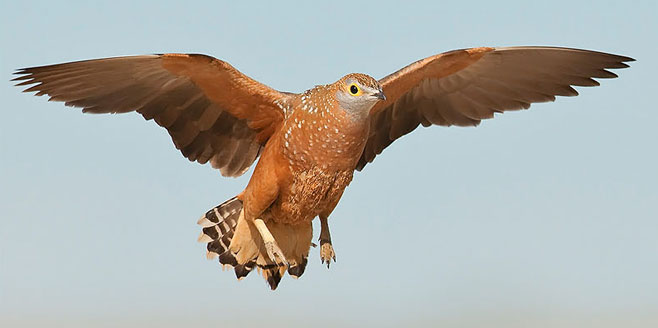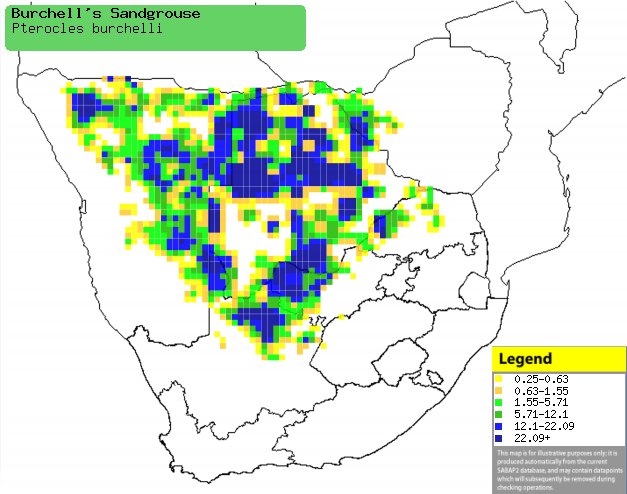|
Pterocles burchelli (Burchell's
sandgrouse)
Gevlekte sandpatrys [Afrikaans]; Simbote (generic term for
sandgrouse) [Kwangali]; Bont zandhoen [Dutch]; Ganga de Burchell [French];
Fleckenflughuhn [German]; Cortiçol-malhado [Portuguese]
Life
> Eukaryotes >
Opisthokonta
> Metazoa (animals) >
Bilateria >
Deuterostomia > Chordata >
Craniata > Vertebrata (vertebrates) > Gnathostomata (jawed
vertebrates) > Teleostomi (teleost fish) > Osteichthyes (bony fish) > Class:
Sarcopterygii (lobe-finned
fish) > Stegocephalia (terrestrial
vertebrates) > Tetrapoda
(four-legged vertebrates) > Reptiliomorpha > Amniota >
Reptilia (reptiles) >
Romeriida > Diapsida > Archosauromorpha > Archosauria >
Dinosauria
(dinosaurs) > Saurischia > Theropoda (bipedal predatory dinosaurs) >
Coelurosauria > Maniraptora > Aves
(birds) >
Order: Charadriiformes > Family: Pteroclidae
 |
 |
|
Burchell's sandgrouse, Kgalagadi National Park,
South Africa. [photo Johann Grobbelaar ©] |
Burchell's sandgrouse in flight, Kgalagadi
National Park, South Africa. [photo
Johann Grobbelaar ©] |
 |
|
Burchell's sandgrouse, Kgalagadi National Park,
South Africa. [photo Johann Grobbelaar ©] |
Distribution and habitat
Near-endemic to southern Africa, occurring from
south-eastern Angola to Namibia (excluding the most arid areas closer to the
coast), Botswana and northern South Africa. It generally prefers areas with red
Kalahari sands with patches of grass and scattered shrubs.
|
 |
|
Distribution of Burchell's sandgrouse in southern
Africa, based on statistical smoothing of the records from first SA Bird
Atlas Project (©
Animal Demography unit, University of
Cape Town; smoothing by Birgit Erni and Francesca Little). Colours range
from dark blue (most common) through to yellow (least common).
See here for the latest distribution
from the SABAP2. |
Predators and parasites
Movements and migrations
Resident and locally nomadic, moving in
response to availability of food and water.
Food
It mainly eats seeds, especially of legumes, doing most of its
foraging in pairs or small flocks during the day. The following food items have been recorded
in its diet:
- seeds
- Lophiocarpus burchelli (Sandaarbossie)
- Requernia sphaerosperma (Red pea)
- Tephrosia
Breeding
- Monogamous solitary nester, with a simple nest consisting of a scrape in
sandy soil, sparsely lined with dry plant material and typically placed next
to a grass tuft or shrub.
- Egg-laying season is in the dry winter months, from April-October.
- It lays three, rarely two eggs.
- There is little information regarding the chicks, however it is likely
that the development and care of the young is similar to that of other sandgrouse, with the female gathering water for its young in its belly
feathers and both parents accompanying their young when they leave the nest.
Threats
Not threatened, in fact it has greatly benefited from the
sinking of boreholes by stock farmers, as this has enabled it to colonise more
arid areas than was previously possible.
References
-
Hockey PAR, Dean WRJ and Ryan PG 2005. Roberts
- Birds of southern Africa, VIIth ed. The Trustees of the John Voelcker
Bird Book Fund, Cape Town.
|
